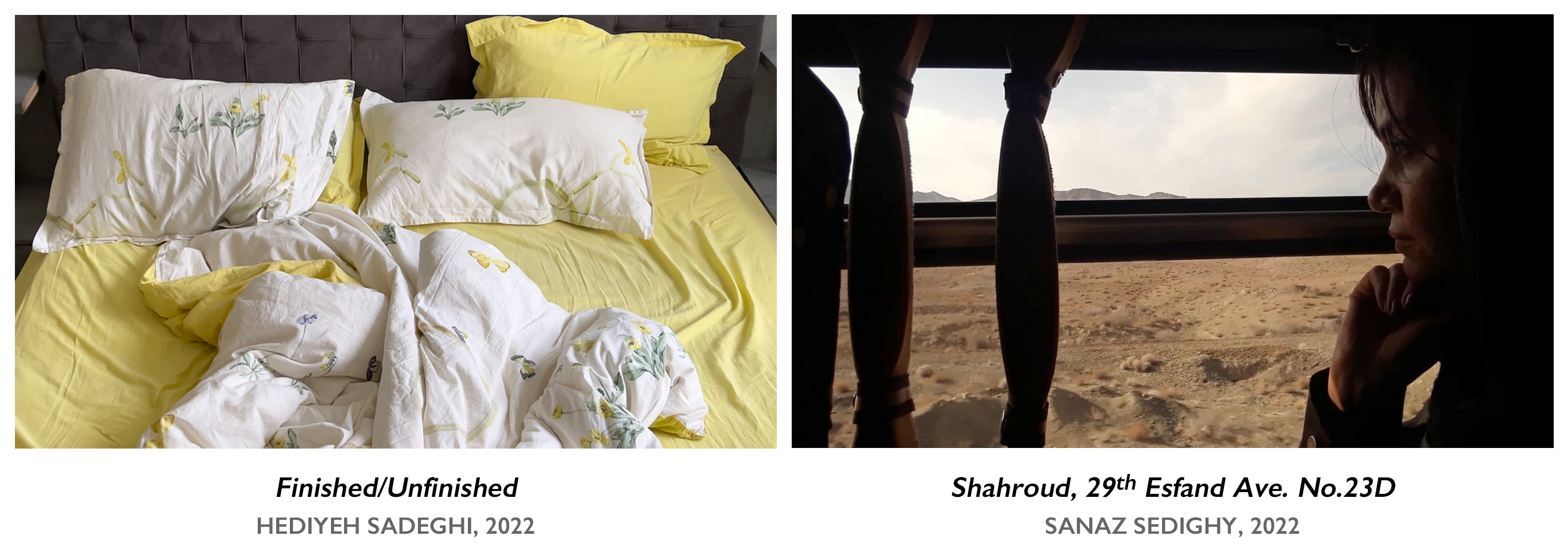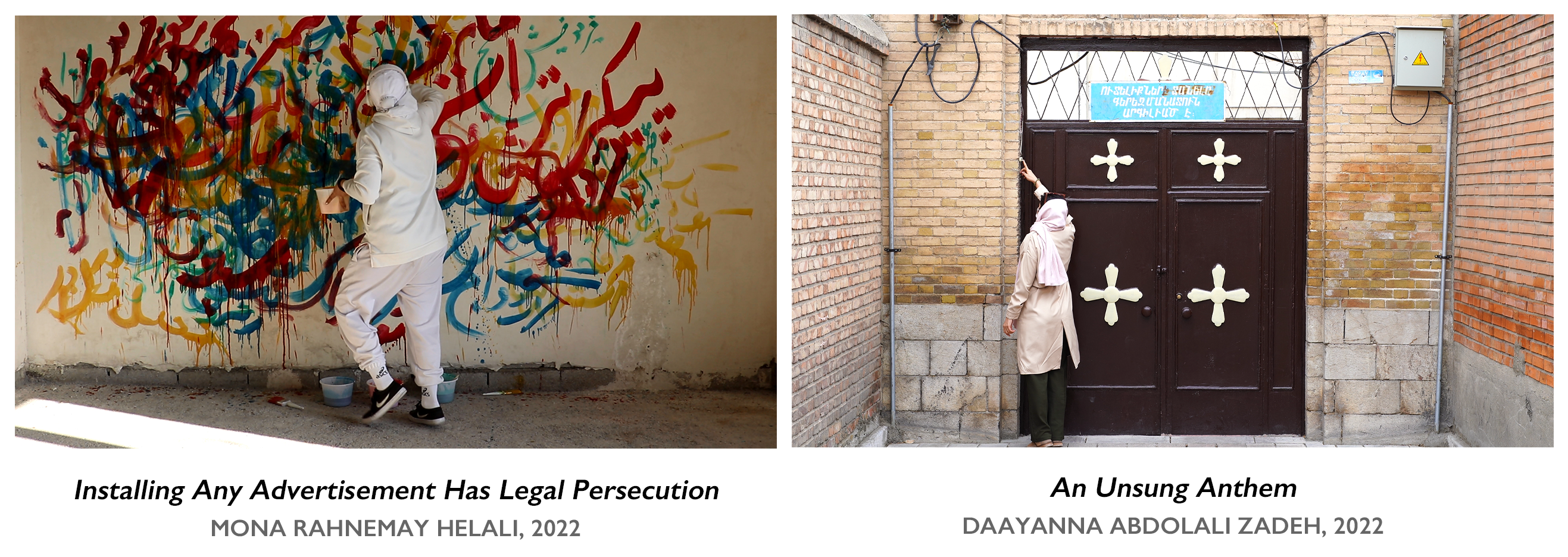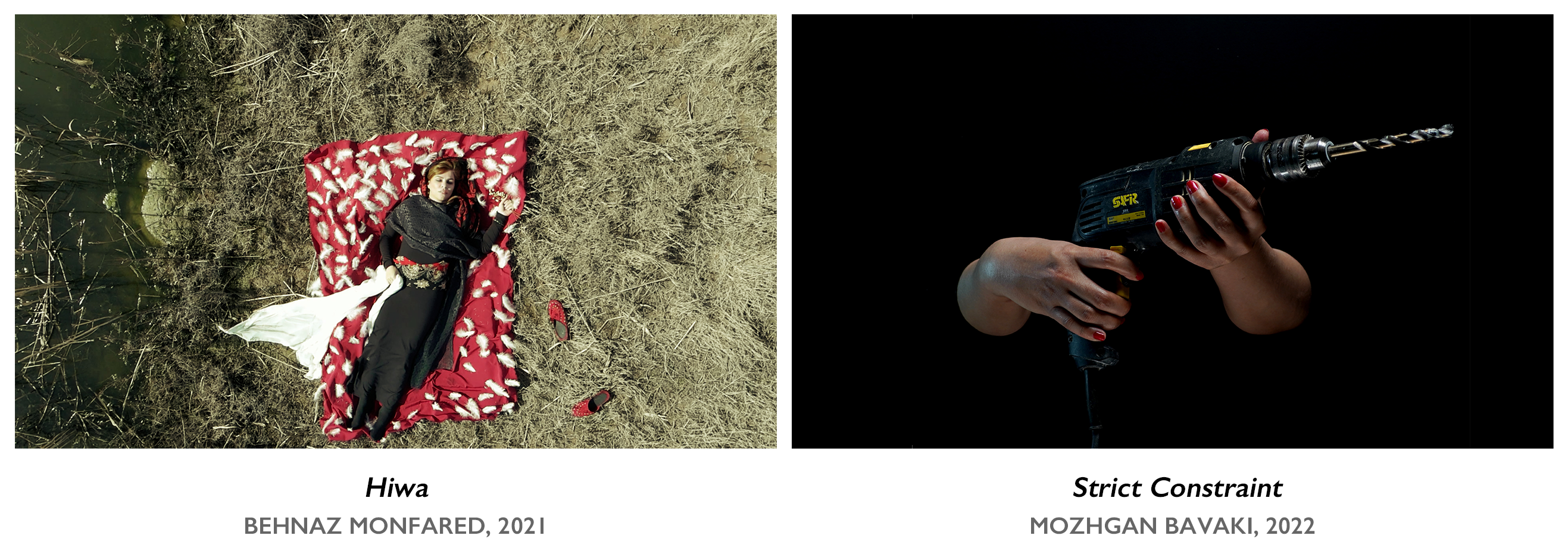


Exhibition of Video Art Works Co-produced by Factory TT
18-22 February 2022
Aria Art Gallery, Tehran, Iran ![]()
![]()
Every Cloud Has A Silver Lining: free download books in PDF![]()

A Project by Shahram Entekhabi
Participaiting artists: Daayanna Abdolali Zadeh ; Mozhgan Bavaki ; Behnaz Monfared ; Mona Rahnemay Helali ; Hediyeh Sadeghi and Sanaz SedighyFactory TT's Video Art Collection ![]()
Daayanna Abdolali Zadeh, Hediyeh Sadeghi, Mozhgan Bavaki, Mona Rahnemay Helali, Sanaz Sedighy and Behnaz Monfared, artists who from different
cities, are inspired by the contemporary living conditions in Iran and the realities of life there. The artists are invited to an exhibition of their works created in the workshop From Idea to Exhibition held in December 2021 at the Aria School. The exhibition Every cloud has a silver lining is presented as the result of the workshop organized by Factory TT. The workshops include an art-history section in which participants explore contemporary art and key works from the international history of video art and a practical part that introduces them to the basics of producing a video art work. In general, the development of a concept for storytelling and film expresses the post-production stages and the layout and presentation to the audience. Since the participants in the workshop are exclusively female artists, they are well-aware of the necessity and benefits of using the media and they have used it in the production of their works. This can be described as an advantage, an internal consistency and a historical necessity.
It is a historical fact that in the early stages of the formation of video art in the 1970s, this medium was discovered by female artists. They took advantage of the fact that the first video-cameras were portable, they were recording sound and images simultaneously, and with the help of a monitor attached to the camera, enabled immediate viewing of the recorded image. This shows that video media is fundamentally different from film, because film could only be produced through the cooperation of a team: Image and sound were recorded separately and the film material had to be developed in a laboratory before it could be viewed by the filmmaker. Thus, the history of art in relation to video speaks of the great process of independence in the field of moving images.
It is important for Entekhabi and Salimian, who are well acquainted with the early stages of feminist video art, to introduce the younger generation of Iranian artists to the possibilities of moving images, to answer questions about gender maps and to promote their observations of social and historical issues and the promotion of media art processes. The works produced by the artists in this project are related to the reality of life in contemporary Iran. They reflect the various themes in which women often appear as protagonists. Observations of life with a focus on everyday life, historical references, the lives of religious minorities, traditional gender maps or body-related "auctions" through the sale of organs, as well as the wide-spread habit to change the face and body through plastic surgery. It also states that the egalitarian forces and the ubiquitous capitalist beauty industry are a threat to everyone. Sometimes it refers to a journey into the past and history, and to the fact that there is no way to revive the past, but the hope of building a future remains strong.
Aria Gallery and Aria School have been operating since 1992 and they are one of the pioneers of post-revolutionary teaching of contemporary art and art criticism in Iran. The works in this exhibition were reviewed and selected by Kathrin Becker (Berlin based curator and author, who from 2001 to 2019 worked as a curator and head of n.b.k. Video-Forum of Neuer Berliner Kunstverein and from February 2020 as the artistic director of KINDL (Centre for Contemporary Art, Berlin). The exhibition Every cloud has a silver lining with the supervision and guidance of Shahram Entekhabi and the curator of Asieh Salimian will be held in Aria Gallery from 18- 22 February 2022 .
This exhibition is in line with the activities of the Factory TT Platform in recent years, with the aim of holding exhibitions of works by young artists in Iran and Europe and by inviting foreign artists to Iran to exhibit their work. Also to challenge "blind spots", to work towards a change in perspective and to try to take a new approach to contemporary art in Iran. The concept of transculturality is our guideline: it sketches a different picture of the relationships between cultures, not one of isolation or conflict, but one of entanglement, intermingling and commonality. The teaching of this workshop, which was undertaken by Shahram Entekhabi, is not his first teaching experience in Iran, but includes his long experience of teaching in different countries. As his work is influenced by international issues, his educational activities are also involved in cultural exchanges between the tart fields of Iran and Europe, especially Germany, where he is participating actively in the Berlin art scene.
As an artist living and working in Berlin, he has exhibited his work internationally and earned a reputation and a place for himself. He brings to his seminars and workshops what he has seen, read and discussed throughout his long career. The exhibition Every cloud has a silver lining is based on his teaching activity and, above all, on his observations that despite the rich tradition of film in Iran, there are few possibilities in the field of video art. Also, little information about the history of video art and rare opportunities for showing and producing are available in the country. Shahram Entekhabi and Asieh Salimian have held exhibitions in recent years that show video art exclusively: For example, the Upgrade exhibition, which was held in September 2017 at the Mahe Mehr Gallery, and the My Very First Time exhibition, which was held at the Ace Gallery in June and July 2016. One of our major goals in the Factory TT is to expand the Factory TT Video Art Collection, which is an archive of historical Iranian video art and contemporary productions, both at home and abroad, which may have been less discussed in the historiography of contemporary Iranian art.
Factory TT Video Art Collection is an online video archive that gives moving images a fixed position and provides background information to visitors. The Factory TT Video Art Collection focuses on feminist activities, ecology and the environment, media influences, and video performances. Another Factory TT activity refers to institutional critique of those structures that are in charge of the contemporary Iranian art scene and its defined places. An example for these critical activities of Factory TT is the implementation of the site-specific exhibition City of Tales and the presentation of works within that context with a variety of techniques and media, curated by Asieh Salimian on the 7th and 8th of May, 2016 in Tehran .
Questions can be asked using these artistic phenomena, which indicate new action to understand social concerns, including the abuse of power, injustice, exploitation, and related issues. In general, site-specific exhibitions bring together art commissioners, curators and artists in the public space to catalyze the impact of their work in the public sphere, in communities and cities and to discuss how it can provide opportunities for rethinking, reviving, and revisiting the future civic landscape. Here we should mention the Tabdil / Tolid ARDABIL (Conversion / Production ARDABIL) project, the First Performance and Environmental Art Festival in Ardabil, Iran. One of the last activities of Factory TT is the Pass virtual exhibition, which was held in Tehran from July to September 2021.
Mozhgan Bavaki has a diploma in Ceramics and a bachelor's degree in Graphic. She is a member of the Iranian Pottery Artists Association and by attending two Iranian ceramic biennials and several group art exhibitions and festivals with a contemporary art approach, she expresses her concern that has been social issues. In her video Strict Constraint, she uses the hand, which plays an important role in human communication. She has reduced this performance to two hands, who are in front of the camera, the hosts or the heroes of these dialogues. The artist is questioning pre-defined gender roles that are present from the Stone Age until now: The ancient model of men hunting and women collecting berries and bringing up children is still the basic structure of society that is based on a special division of roles: the man as the breadwinner and the provider, and the woman as the housewife, the mother and the wife... In this video, we see a male hand and a female hand in different positions doing different things. Sometimes a man's hand matches traditional feminine features such as painted nails. Sometimes traditionally "female" actions like cleaning vegetables, or embroidering, or so-called "masculine" activities such as working with a machine or using boxing gloves are challenges by the video Strict Constraint when acted out by the hand of he opposite gender. The video conversations, which are also told by a man and a woman, continue to reflect traditional gender stereotypes and patterns.
Mona Rahnemay Helali has a bachelor's degree in Cellular and Molecular Biology and a master's degree in Genetics. She is a multimedia artist who has produced acclaimed social and critical themes through photography, sculpture, and installation, and has appeared in more than twenty prestigious group exhibitions, domestic and international events. Mona's work is based on a collection of advertisements, billboards, and posters in the public space. These "pollution" deprive us of seeing and enjoying a view of a facade, they are harmful changes in the urban or suburban environments. The content of these ads are related to the human body and its capitalization: Some ads deal with the buying and selling of human kidneys, some are special offers for a onsensual divorce or are an encouragement to buy decorative and luxury goods, some offer plastic surgery, Botox injections, or liposuction. In the video, the artist is wearing headphones and is hearing various slogans from influencers and of advertisements. While listening to these messages, she paints them on the wall, similar to the work of artists who use graffiti. Mona writes the texts continuously on the wall until they merge and cover each other. These palimpsests, which contain a multitude of advertising messages, become increasingly unreadable until the protagonist leaves the stage with a gesture of withdrawal and tiredness of continuing. This work is a critique of neoliberal reality and the marketing of individuals and economic entities for profit.
Hediyeh Sadeghi has a bachelor's and master's degree in Metallurgical Engineering, has freely offered theoretical courses in Philosophy, Art and Painting, and has exhibited her works in five group exhibitions so far. In her works, Hediyeh seeks a way to reach the meaning and concept of life. By exploring the surroundings and lived experience, she shows the importance of moments and meditates on them and tries to perceive her true self. In the Finished/Unfinished video, she discusses everyday life as a key concept in cultural and sociological studies. By reflecting on and depicting everyday life, she has been motivated by the derogatory effects of capitalism and industrialism on human existence and perception. The artist argues with reference to everyday life dating back to ancient Greece, medieval Christianity and the period of Enlightenment. A repetitive view of everyday life is often seen as negative, and is distinctly separated from exceptional moments because of its indistinguishability, which is ultimately defined as the necessary and obvious continuation of worldly activity, and depicts the onslaught of more inward experiences. In scenes of brushing, eating, turning the lights on and off, Hediyeh Sadeghi depicts the moments of life for which all human endeavors are made, along with a scattered inner monolog about today.
Sanaz Sedighy has completed her studies in Sculpture and new and interdisciplinary Media in Iran and Italy and has participated in numerous group events and exhibitions in Italy. She currently works in visual art, interdisciplinary arts and applied ceramics. In the video Shahroud, 29 Esfand Ave. No. 23, the protagonist, who is played by the artist herself, takes the viewer on a journey that begins in a small town. She spent her childhood in Tehran and her youth and educational years in Florence. Sedighy takes us back to her grandmother's house in the small town of Shahroud. In the video Sanaz depicts the process of going back to the past, of hoping for the future and for looking for a new beginning. She accidentally arrives at a house that is being demolished and gradually disappears. She is realizing that it is impossible to return. Sanaz Sedighy travels to the past and at the same time moves forward to the future, inviting the audience to a common and highly emotional experience, the experience of longing. In this journey, the artist and the audience focus on important social connections and meaningful personal events with a nostalgic feeling around them.
Daayanna Abdolali Zadeh holds a master's degree in Architectural Engineering. She is an architect with a Tehran based research practice. Also she produces works in photography and painting. The video An unsung anthem can be described as a "search for the past" and a cinematic journey to discover the past: "We are all the product of our past and our parents and grandparents". In the film, she follows the footsteps of a girl she saw in a photo on a tombstone in an Armenian cemetery, seeking to answer the question of how she would deal with such a past. In this film, she follows an unknown person who lives in a house that has always aroused a strange feeling in her. Thinking about who she is leads Daayanna Abdolali Zadeh to the past of a house about which she has little information. It is a journey into parallel worlds and closed rooms, a sacred place, putting oneself somewhere else, a new story, poetical and symbolical. The camera accompanies Abdolali Zadeh in search of her roots in quiet images. The scenes form a bridge on which the artist walks, goes shopping and does everyday things and remembers or imagines. Daayanna does not want to give any answer, but by creating a space for reflection, she invites the viewer to travel and explore.
Behnaz Monfared is a graphic designer, illustrator and peace activist. By attending prestigious solo and group exhibitions domestically and internationally (Netherlands, Austria, Serbia), she shares her concerns of the last few years on the subject of peace, war and chemical weapons. In most of her projects, she deals with how women achieve hope in difficult situations such as war. Behnaz Monfared tries to reflect peace and hope through her art works by using various techniques. She believes that each technique can express a different part of the subject. She is trying to continue her future projects with a greater focus on the issue of "inner peace". In her video Hiwa, she deals with a catastrophe that is little discussed in Iran: Explosions do not always end in death, but they can cause serious health damage, such as blindness, skin burns, or adverse effects on the fetus. Some chemical weapons contaminate the environment to such an extent that its long-term effects on humans can be hardly denied. The use of chemical weapons in warfare has been known since ancient times. In the past, incendiary substances such as oil, Greek fire, or later on a small scale, chemical toxins such as arsenic were used. The Spartans used incendiary devices that caused high concentrations of sulfur dioxide in the air. In her video Hiwa, Behnaz Monfared discusses the long-term consequences and effects of chemical weapons while visiting the chemically treated areas and talking with the survivors of chemical accidents. She introduces us to a world in which millions of people have been chemically attacked. Although the victims have been treated as much as possible, they continue to live with the consequences and effects of the rest of their lives.
Asieh Salimian,
February 2022